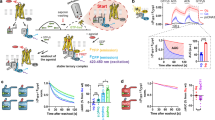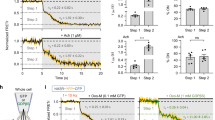Abstract
The interaction of G protein–coupled receptors (GPCRs) with heterotrimeric G proteins represents one of the most fundamental biological processes. However, the molecular architecture of the GPCR–G protein complex remains poorly defined. In the present study, we applied a comprehensive GPCR–G protein α subunit (Gα) chemical cross-linking strategy to map a receptor-Gα interface, both before and after agonist-induced receptor activation. Using the M3 muscarinic acetylcholine receptor (M3R)-Gαq system as a model system, we examined the ability of ~250 combinations of cysteine-substituted M3R and Gαq proteins to undergo cross-link formation. We identified many specific M3R-Gαq contact sites, in both the inactive and active receptor conformations, allowing us to draw conclusions regarding the basic architecture of the M3R-Gαq interface and the nature of the conformational changes following receptor activation. As heterotrimeric G proteins as well as most GPCRs share a high degree of structural homology, our findings should be of broad general relevance.
This is a preview of subscription content, access via your institution
Access options
Subscribe to this journal
Receive 12 print issues and online access
$259.00 per year
only $21.58 per issue
Buy this article
- Purchase on Springer Link
- Instant access to full article PDF
Prices may be subject to local taxes which are calculated during checkout






Similar content being viewed by others
References
Pierce, K.L., Premont, R.T. & Lefkowitz, R.J. Seven-transmembrane receptors. Nat. Rev. Mol. Cell Biol. 3, 639–650 (2002).
Lagerström, M.C. & Schiöth, H.B. Structural diversity of G protein–coupled receptors and significance for drug discovery. Nat. Rev. Drug Discov. 7, 339–357 (2008).
Regard, J.B., Sato, I.T. & Coughlin, S.R. Anatomical profiling of G protein–coupled receptor expression. Cell 135, 561–571 (2008).
Cabrera-Vera, T.M. et al. Insights into G protein structure, function, and regulation. Endocr. Rev. 24, 765–781 (2003).
Palczewski, K. et al. Crystal structure of rhodopsin: a G protein–coupled receptor. Science 289, 739–745 (2000).
Warne, T. et al. Structure of a β1-adrenergic G-protein-coupled receptor. Nature 454, 486–491 (2008).
Cherezov, V. et al. High-resolution crystal structure of an engineered human β2-adrenergic G protein–coupled receptor. Science 318, 1258–1265 (2007).
Rasmussen, S.G. et al. Crystal structure of the human β2 adrenergic G-protein-coupled receptor. Nature 450, 383–387 (2007).
Jaakola, V.P. et al. The 2.6 angstrom crystal structure of a human A2A adenosine receptor bound to an antagonist. Science 322, 1211–1217 (2008).
Park, J.H., Scheerer, P., Hofmann, K.P., Choe, H.W. & Ernst, O.P. Crystal structure of the ligand-free G-protein-coupled receptor opsin. Nature 454, 183–187 (2008).
Scheerer, P. et al. Crystal structure of opsin in its G-protein-interacting conformation. Nature 455, 497–502 (2008).
Oldham, W.M. & Hamm, H.E. How do receptors activate G proteins? Adv. Protein Chem. 74, 67–93 (2007).
Oldham, W.M. & Hamm, H.E. Heterotrimeric G protein activation by G-protein-coupled receptors. Nat. Rev. Mol. Cell Biol. 9, 60–71 (2008).
Johnston, C.A. & Siderovski, D.P. Receptor-mediated activation of heterotrimeric G-proteins: current structural insights. Mol. Pharmacol. 72, 219–230 (2007).
Wess, J. Molecular basis of receptor–G-protein-coupling selectivity. Pharmacol. Ther. 80, 231–264 (1998).
Hamm, H.E. et al. Site of G protein binding to rhodopsin mapped with synthetic peptides from the α subunit. Science 241, 832–835 (1988).
Onrust, R. et al. Receptor and βγ binding sites in the α subunit of the retinal G protein transducin. Science 275, 381–384 (1997).
Conklin, B.R., Farfel, Z., Lustig, K.D., Julius, D. & Bourne, H.R. Substitution of three amino acids switches receptor specificity of Gqα to that of Giα. Nature 363, 274–276 (1993).
Cai, K., Itoh, Y. & Khorana, H.G. Mapping of contact sites in complex formation between transducin and light-activated rhodopsin by covalent cross-linking: use of a photoactivatable reagent. Proc. Natl. Acad. Sci. USA 98, 4877–4882 (2001).
Itoh, Y., Cai, K. & Khorana, H.G. Mapping of contact sites in complex formation between light-activated rhodopsin and transducin by covalent cross-linking: use of a chemically preactivated reagent. Proc. Natl. Acad. Sci. USA 98, 4883–4887 (2001).
Johnston, C.A. & Siderovski, D.P. Structural basis for nucleotide exchange on Gαi subunits and receptor coupling specificity. Proc. Natl. Acad. Sci. USA 104, 2001–2006 (2007).
Wess, J. Molecular biology of muscarinic acetylcholine receptors. Crit. Rev. Neurobiol. 10, 69–99 (1996).
Zeng, F.Y., Hopp, A., Soldner, A. & Wess, J. Use of a disulfide cross-linking strategy to study muscarinic receptor structure and mechanisms of activation. J. Biol. Chem. 274, 16629–16640 (1999).
Cai, K. et al. Single-cysteine substitution mutants at amino acid positions 306–321 in rhodopsin, the sequence between the cytoplasmic end of helix VII and the palmitoylation sites: sulfhydryl reactivity and transducin activation reveal a tertiary structure. Biochemistry 38, 7925–7930 (1999).
Ernst, O.P. et al. Mutation of the fourth cytoplasmic loop of rhodopsin affects binding of transducin and peptides derived from the carboxyl-terminal sequences of transducin α and γ subunits. J. Biol. Chem. 275, 1937–1943 (2000).
Swift, S. et al. Role of the PAR1 receptor 8th helix in signaling: the 7–8-1 receptor activation mechanism. J. Biol. Chem. 281, 4109–4116 (2006).
Delos Santos, N.M., Gardner, L.A., White, S.W. & Bahouth, S.W. Characterization of the residues in helix 8 of the human β1-adrenergic receptor that are involved in coupling the receptor to G proteins. J. Biol. Chem. 281, 12896–12907 (2006).
Wedegaertner, P.B., Chu, D.H., Wilson, P.T., Levis, M.J. & Bourne, H.R. Palmitoylation is required for signaling functions and membrane attachment of Gqα and Gsα. J. Biol. Chem. 268, 25001–25008 (1993).
Edgerton, M.D., Chabert, C., Chollet, A. & Arkinstall, S. Palmitoylation but not the extreme amino-terminus of Gqα is required for coupling to the NK2 receptor. FEBS Lett. 354, 195–199 (1994).
Chabre, O., Conklin, B.R., Brandon, S., Bourne, H.R. & Limbird, L.E. Coupling of the α2A-adrenergic receptor to multiple G-proteins. A simple approach for estimating receptor–G-protein coupling efficiency in a transient expression system. J. Biol. Chem. 269, 5730–5734 (1994).
Spalding, T.A., Burstein, E.S., Brauner-Osborne, H., Hill-Eubanks, D. & Brann, M.R. Pharmacology of a constitutively active muscarinic receptor generated by random mutagenesis. J. Pharmacol. Exp. Ther. 275, 1274–1279 (1995).
Li, J.H. et al. Distinct structural changes in a G protein–coupled receptor caused by different classes of agonist ligands. J. Biol. Chem. 282, 26284–26293 (2007).
Rebois, R.V. & Hébert, T.E. Protein complexes involved in heptahelical receptor-mediated signal transduction. Receptors Channels 9, 169–194 (2003).
Nobles, M., Benians, A. & Tinker, A. Heterotrimeric G proteins precouple with G protein–coupled receptors in living cells. Proc. Natl. Acad. Sci. USA 102, 18706–18711 (2005).
Galés, C. et al. Real-time monitoring of receptor and G-protein interactions in living cells. Nat. Methods 2, 177–184 (2005).
Clark, M.A., Sethi, P.R. & Lambert, N.A. Active Gαq subunits and M3 acetylcholine receptors promote distinct modes of association of RGS2 with the plasma membrane. FEBS Lett. 581, 764–770 (2007).
Lohse, M.J. et al. Optical techniques to analyze real-time activation and signaling of G-protein-coupled receptors. Trends Pharmacol. Sci. 29, 159–165 (2008).
Moro, O., Lameh, J., Högger, P. & Sadée, W. Hydrophobic amino acid in the i2 loop plays a key role in receptor–G protein coupling. J. Biol. Chem. 268, 22273–22276 (1993).
Wacker, J.L. et al. Disease-causing mutation in GPR54 reveals the importance of the second intracellular loop for class A G-protein-coupled receptor function. J. Biol. Chem. 283, 31068–31078 (2008).
Bornancin, F., Pfister, C. & Chabre, M. The transitory complex between photoexcited rhodopsin and transducin. Eur. J. Biochem. 184, 687–698 (1989).
Ballesteros, J.A. & Weinstein, H. Integrated methods for modeling G-protein coupled receptors. Methods Neurosci. 25, 366–428 (1995).
Hubbell, W.L., Altenbach, C., Hubbell, C.M. & Khorana, H.G. Rhodopsin structure, dynamics, and activation: a perspective from crystallography, site-directed spin labeling, sulfhydryl reactivity, and disulfide cross-linking. Adv. Protein Chem. 63, 243–290 (2003).
Altenbach, C., Kusnetzow, A.K., Ernst, O.P., Hofmann, K.P. & Hubbell, W.L. High-resolution distance mapping in rhodopsin reveals the pattern of helix movement due to activation. Proc. Natl. Acad. Sci. USA 105, 7439–7444 (2008).
Oldham, W.M., Van Eps, N., Preininger, A.M., Hubbell, W.L. & Hamm, H.E. Mechanism of the receptor-catalyzed activation of heterotrimeric G proteins. Nat. Struct. Mol. Biol. 13, 772–777 (2006).
Kapoor, N., Menon, S.T., Chauhan, R., Sachdev, P. & Sakmar, T.P. Structural evidence for a sequential release mechanism for activation of heterotrimeric G proteins. J. Mol. Biol. 393, 882–897 (2009).
Javitch, J.A. The ants go marching two by two: oligomeric structure of G-protein-coupled receptors. Mol. Pharmacol. 66, 1077–1082 (2004).
Milligan, G. & Bouvier, M. Methods to monitor the quaternary structure of G protein–coupled receptors. FEBS J. 272, 2914–2925 (2005).
Acknowledgements
This research was supported by the Intramural Research Program of the US National Institute of Diabetes and Digestive and Kidney Diseases (US National Institutes of Health) and used the high-performance computational capabilities of the Biowulf Linux cluster at the US National Institutes of Health, Bethesda, Maryland, USA (http://biowulf.nih.gov).
Author information
Authors and Affiliations
Contributions
J.H. designed and conducted most of the biochemical experiments. Y.W., X.Z. and J.L. were involved in the pharmacological characterization of the mutant proteins. J.R.L. carried out the mass spectrometry studies. S.C. designed the molecular modeling studies. S.C. and J.K. carried out the molecular modeling studies. J.W. designed the experiments, and J.H., S.C. and J.W. wrote the paper.
Corresponding authors
Ethics declarations
Competing interests
The authors declare no competing financial interests.
Supplementary information
Supplementary Text and Figures
Supplementary Methods and Supplementary Results (PDF 18079 kb)
Supplementary Data
Stand-alone supplementary data (PDB 1280 kb)
Rights and permissions
About this article
Cite this article
Hu, J., Wang, Y., Zhang, X. et al. Structural basis of G protein–coupled receptor–G protein interactions. Nat Chem Biol 6, 541–548 (2010). https://doi.org/10.1038/nchembio.385
Received:
Accepted:
Published:
Issue Date:
DOI: https://doi.org/10.1038/nchembio.385
This article is cited by
-
Molecular mechanism of muscarinic acetylcholine receptor M3 interaction with Gq
Communications Biology (2024)
-
Mapping the conformational landscape of the stimulatory heterotrimeric G protein
Nature Structural & Molecular Biology (2023)
-
Coevolution underlies GPCR-G protein selectivity and functionality
Scientific Reports (2021)
-
Membrane protein-regulated networks across human cancers
Nature Communications (2019)
-
Propagation of conformational changes during μ-opioid receptor activation
Nature (2015)



